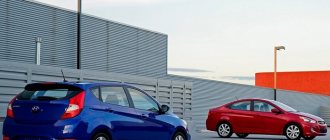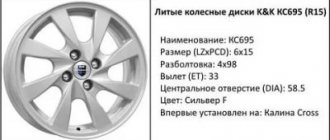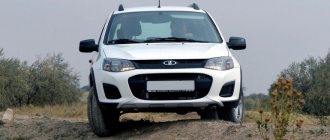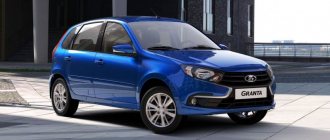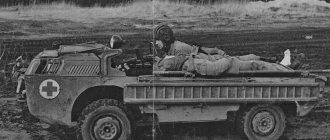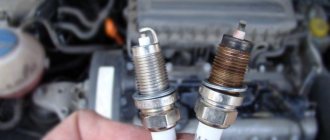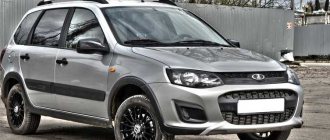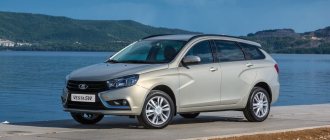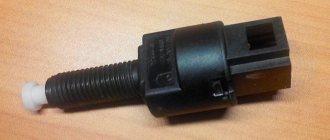Liftback
A liftback is a type of closed car body that is intermediate between a sedan, station wagon and hatchback. It differs from the hatchback in the longer rear overhang: the liftback has the same length as the sedan. The rear part of the roof can be either sloping or (less often) stepped, reminiscent of a sedan.
Body type Liftback
Sedan
Such a car has a protruding hood and trunk, separated from the passenger compartment and with a separate door. A sedan may have an extended wheelbase - in this case, the sedan is a premium class car and its name contains the letter L, from long - long.
The sedan is the most common and popular body type around the world. This is a classic and prestigious body that does not lose its popularity in Belarus.
Audi A6 A6
Crossover or sedan. pros and cons.
When compact crossovers began to catch up and overtake sedans in sales volume in the new car market, heated debate broke out about the validity of this situation. Despite the fact that this situation has been going on for several years, a final answer to the question “crossover or sedan” has not yet been found. I’ll try to formulate five reasons in favor of a crossover and five in favor of a sedan, such as the Hyundai Solaris. Crossover. More cargo space.
Crossovers, like hatchbacks, are more spacious than sedans. Not only that, sometimes even with the rear seats folded down, the trunk volumes of crossovers and sedans are almost the same, but if you fold the back row, crossovers have simply a huge space for transporting anything you want. If you regularly have to transport not only people, but also a lot of things and cargo, this is an obvious plus in favor of a crossover.
Crossover. All-wheel drive is permanent or plug-in.
Do you live in a region where it is not summer all year round? Snow, mud, and even roads of not the best quality? Do you like to travel and go out into nature? Well then, all-wheel drive is what you need. Although, of course, there are sedans with all-wheel drive, but for crossovers it is actually a basic requirement. In fact, if you need better cross-country ability, then you can safely look at all the crossovers on the market, and not look for a few all-wheel drive sedans, which, moreover, often cost quite an outrageous amount of money.
Crossover. Boarding of the driver and passengers.
One of the reasons for the popularity of crossovers was the high seating position of the driver and passengers. A seating format that allows the driver to sit higher than in a sedan, along with reasonable fuel economy, makes crossovers more popular than old-school cast-iron SUVs. In urban environments, better visibility allows you to better see and assess your surroundings.
Crossover. Off-road.
Do you often cross mountain rivers, tractor tracks and small fords? Then a full-fledged SUV is your choice. And in order to get into the forest, through muddy spring mud or a rocky area, a crossover will be more than enough. Sedans really have nothing to do here. Well, if only WRX...
Crossover. More and more great options.
With the growing popularity of the crossover class, manufacturers began to offer ever richer and more interesting configurations, expanding their engine ranges and the amount of additional equipment. Which, in principle, begins to equalize them in terms of comfort and equipment with sedans.
———————————————————————————————
Sedan. Fuel economy.
Although the crossover has come a long way from large SUVs that guzzle buckets of gas, and today can boast of quite interesting efficiency indicators, sedans are still more economical one way or another. On average, a sedan consumes 10-15% less fuel than a crossover. And also interesting: The new cross-coupe Lada Niva Travel 4×4 2021 was shown in the photo. In this body, the SUV will outshine the Kia Sportage
Sedan. Boarding of the driver and passengers.
Life is such that not everything can be measured by averages. And people are often taller than average. Which imposes certain restrictions on cars. If in most C and D class sedans a person with a height of 180 to 200 centimeters will feel quite comfortable, thanks to the reclining seating position, then in most crossovers he will need to open the hatch so as not to rest his head on the roof.
Sedan. Proven design.
Proven does not mean old at all. When buying a Toyota Camry or VW Passat, we know what we are getting. For many years. But what is that same RAV4? Big Prius? Or something else? That is, most crossovers are assembled on a sedan platform. And here the question is - which is better?
Sedan. Visibility.
Parking sensors almost in a circle, all-round cameras, blind spot monitoring systems and much more that have recently begun to be shoved into crossovers without limit, this is an attempt by manufacturers to compensate for not very good visibility and a sense of size (for example, the same Mercedes Benz GLA with visibility point of view is not very good). For a sedan, a rear view camera and parking sensors front and rear are often sufficient.
Sedan. Elegance and style.
Mercedes-BenzCLA-class, FordFusion, KiaOptima, JaguarXF, Dodge Charger, BMW6-series GranCoupe... Continue? In principle, if you really value style in a car, a sedan has much more advantages.
- Hyundai Tucson N Line For quite a long time, sports versions of production cars were the prerogative of exclusively German ones, and well...
- The Audi e-tron is the brand's first production electric car, the world premiere of which took place in San Francisco. Full size…
- While the “cool wheels”, or rather, the photo shoot, are being stored on a flash drive until maturation in the first days of the coming week, I would like to say...
- To look at the latest Russian and foreign mass tuning, all you have to do is come to Vorobyovy Gory and everything will immediately become clear. Trends,…
- This year marks the 50th anniversary of the annual SEMA Show in Las Vegas. This has already become a traditional automobile...
- The automotive world is structured in such a way that, despite sales plans and market trends, exceptions to the rules appear from time to time, which, no matter…
- Even in its previous generation, the Ford F-150 Raptor gained considerable popularity with its aggressive appearance, powerful engine, and all that...
- When the famous Swedish car manufacturer Volvo, which at that time was not in the best shape after a break with Ford,...
- The massive gates rise in front of you and the SEMA Garage appears before your eyes. The place where powerful and famous cars are born. And the first thing...
Two-door sedan originally from the USSR
There are technologies that make it difficult to manufacture B-pillars. In such cases, preference is given to the following options: coupe, two-door sedan, three-door hatchback or liftback. In order for the structure to be durable, the body must be three-volume (sedan, coupe). If we are talking about a mass-produced car, a sedan with two doors remains a suitable option.
The Zarya car project, which appeared in 1966, was developed by specialists from the Severodonetsk auto repair base. The body of this car, made of fiberglass, was mounted on a metal frame. Unfortunately, it was not possible to implement the project to the end, that is, to reach significant production volumes. The technology for producing fiberglass parts turned out to be too labor-intensive. But the car shown in the photo, and other “plastic cars” developed in the USSR at different times, were just two-door sedans. Which is 100% consistent with the ideology discussed above.
Car bodies: their purpose and types
Over the past 20 years, car designers in advanced countries have managed to introduce many original body styles into production. Increasingly, there are those that combine the selected qualities of several car bodies. If previously there were much fewer of them, today the number of individual body types has not only increased, but they have become a decisive link in determining the price and size of the car produced.
Car body type
15 samples of a modern passenger car body – this is the number experts call. And not every amateur can boast that he knows the names of modern bodies, their purpose, advantages and disadvantages.
What defines a body, why is it so important and why are there so many different types needed? All motorists know that the body is the main element of the car, determining its shape and making it possible to transport people, cargo, and so on. The body determines how many passengers can fit in the cabin, what can be put in the trunk, etc.
Types of car bodies
If we consider the grouping of body models in the automotive industry specifically, the differences relate to the following:
- Purpose;
- Design features;
- Load parameters;
- Options, layouts and so on.
Note. You should know that passenger cars have bodies of frameless or semi-frame construction.
As for the body layout, today the following types are distinguished:
- 1-volume, which imply the location of passengers, luggage and the engine in a single spatial volume;
- 2-volume, implying that luggage and people are in the cabin, and the internal combustion engine is under the hood. These body types are characterized by convenient sizes and the presence of a large, spacious luggage compartment;
- 3-volume. In this case, there are people in the cabin, an engine under the hood, and a trunk for cargo. They are considered less versatile among other body types, since their transformation is limited by the protruding front and rear parts.
Load-bearing body of a passenger car
Regarding the load level:
- There is a load-bearing body designed to absorb all loads;
- There is a semi-supporting body that takes only those loads that fall on the frame;
- There is an unloaded body that accepts only the cargo and the mass of passengers.
Body: what you need to know
Over its long history, the automotive industry has produced a huge number of different body types. Many of them have become part of history and can now be seen only in pictures or in museums.
The most popular today are about 10 varieties, which we will talk about today. But, before we move on to descriptions and visual photos, a little boring theory.
Whatever the body may be in terms of the number of doors, the presence or absence of a roof, as well as design, it can always be classified into one of three layout categories, namely:
- single-volume - roughly speaking, in this case, everything and everyone in the car (engine, passengers, luggage) is located inside one conditional compartment of the body, without obvious divisions;
- two-volume - here the hood is clearly visible, under which the power unit is located, and the passenger compartment is, as it were, combined with the luggage compartment;
- three-volume - here they all have their own compartments: a clearly defined hood, passenger compartment and trunk.
For clarity, we provide examples for each category. Prominent representatives of the first are Smart city cars.
Two-volume ones include, for example, the Ford Focus hatchback,
Well, the representative of the third category will be any sedan - “Zhiguli”, as one of the many options.
SUV
An SUV is a vehicle with increased cross-country ability. This is achieved due to increased ground clearance of the body. A classic SUV - a jeep - has a frame body, all-wheel drive, special geometry and a reduction gear.
Today, when they talk about the class of SUVs, SUV (Sport Utility Vehicle), they mean crossovers (SUVs). Driving performance and overall dimensions do not allow them to be classified as “real” SUVs.
Crossovers have 3 or 5 doors, 2 or 3 rows of seats. Today, there are crossovers in liftback or coupe body styles.
Conservatives
The three-volume body has a protruding hood and trunk. Three-volume vehicles are among the least versatile bodies due to the limited possibility of transforming the interior and trunk. This group includes sedans, coupes, convertibles and pickups.
Sedan, coupe
The most striking representative of the three-volume body is the sedan, which is present in the model range of almost all manufacturers. The sedan is considered the most conservative (classic) and prestigious body type. The sedan is extremely popular on our roads, where “prestige is everything,” and cars are divided into sedans and non-sedans.
A convertible is a coupe with a “soft” tent roof that folds behind the rear seats and rises if necessary.
But the soft top did not allow the car to be used all year round, so in the late 90s a new version of the open body began to gain popularity - the coupe-convertible. At first glance, it looks like a regular coupe, but when you press the right button, the hard metal roof lifts up and neatly folds into the trunk, turning the coupe into a convertible.
A two-seater convertible (without a second row of seats) is called a roadster (for example).
Pickup
A pickup truck is a body with an open cargo area separated from the interior by a rigid partition. Simply put, it is a smaller copy of a regular truck. Most pickup trucks are built on the same platform as SUVs and have good cross-country ability. Both here and throughout Europe, pickup trucks are not particularly popular, but in the USA they are crazy about them.
Another way
Many years of experience in operating a wide variety of vehicles suggests that in urban environments, many of the off-road advantages of crossovers can be replaced by other means.
That is, we want to say that you can buy a single-wheel drive version of the crossover and, under certain conditions, it will perform its tasks no worse than in the all-wheel drive configuration. On freshly fallen or compacted snow, on wet primers with local puddles and shallow ruts, all-wheel drive will largely replace good tires. They should have large lugs, massive blocks of lamellas, and wide grooves. If you mean “winter”, then it is better to choose Arctic models with good traction on ice.
In difficult road conditions, driving skill matters a lot. No all-wheel drive will help if you don’t know how to move off smoothly, “tightly”, without slipping, including from second gear. Practice a technique called rocking: using the inertia of the car, you can drive out of holes dug by wheels, mud and snowdrifts, even on a mono-wheel drive.
Finally, without such banal old-fashioned tools in the trunk as chains, a shovel, sand and a cable, in winter many residents of the outback do not even drive cars with all-wheel drive.
So, before deciding whether to pay extra money for an all-wheel drive package, once again compare information about the model's capabilities and the conditions in which you intend to use it. The “4x4” nameplate is not always worth what they ask for it.
You can compare crossover cars after determining which models should be classified in this class and by what parameters the comparison can be made. This is how you can understand which crossover is the most popular and combines the most successful characteristics.
Being something between an SUV and a passenger car, crossovers have firmly taken one of the leading positions in the list of the most popular models.
The most popular body types
This is one of the most popular designs in the 20th century. The body has 2-4 doors, inside the cabin there are seats for 4-5 passengers and the driver. Outside the cabin, in separate compartments, there is luggage and the car's engine.
Reference. In different countries this type is called differently. In England - Saloon, among the German population the name Limousine is popular, and in France - Berline.
This type is the successor to the station wagon and is quite popular among buyers. It combines comfort for passengers and the convenience of transporting small loads. The latter is achieved by folding a row of passenger seats.
This type was popular in the bygone 20th century. There are two rows of seats inside, and there is a fifth door at the back. The luggage compartment and passenger compartment are a single unit.
This body, depending on the car model, can have two or three volumes. It is characterized by a rear overhang, similar to a sedan, and a sloping roof, like a hatchback.
This option is also a favorite among car owners. It is a design with two doors and seats arranged in one row. In rare cases, additional seats will be installed in the rear. They are designed more for transporting children or accommodating pets.
Reference. The demands of modern times dictate their own rules, and coupes with a full-size second row of seats have begun to appear on the market. This includes high-end sports cars and small cars for urban use.
Expensive sports cars are created on the basis of this body. A distinctive feature is the absence of a hard roof; it is replaced by a folding awning against bad weather.
This variant is a relative of the convertible. Unlike its predecessor, it has only one row of seats, designed for two people. The roof has also been replaced with a folding fabric structure.
The limousine is designed for luxury cars; it has all the conditions for the convenience and comfort of passengers. This type is characterized by a spacious interior and a partition between the driver and passenger seats.
SUV
Another popular name among car enthusiasts is jeep. The characteristic features of this type are its large size, five or six doors, and two volumes are visually defined. Inside the cabin there are two or three rows of passenger seats. An SUV is most similar to a station wagon. The frame and body of the car do not interact with each other; the body belongs to the unloaded class.
In another way, this body type is called a “SUV”. Unlike an SUV, the body is monocoque, consisting of two volumes. Dimensions and ground clearance differ from an SUV to a smaller extent.
This type is most popular among North Americans. It has a large load capacity thanks to the open platform at the rear. The cabin has one row of seats and two doors.
This is a variant of a cargo-passenger vehicle. There are several modifications:
- station wagon based;
- based on a cargo chassis, complemented by a passenger cabin and an awning;
- based on a pickup truck.
A common feature of all vans is that the design consists of passenger seats and a metal cargo part at the rear of the vehicle.
This type is an intermediate stage between a station wagon and a minibus. Another name (rarely used) is a high-capacity station wagon. It is a one- or two-volume body with a half-hood design. It can have both two and three rows of seats in the cabin.
Hatchback
The second most popular body style is occupied by hatchback cars. Their main difference from the sedan is the absence of a protruding trunk. This role in the “truncated” rear part of the car is played by a luggage compartment closed by a massive rear door.
The reason for the popularity of hatchbacks in Europe is their compact dimensions and maneuverability. There is also a special type of this type of body – liftbacks. Liftbacks have a trunk lid, but it opens along with the rear window.
Skoda Fabia Fabia
Classification of passenger car bodies
Car bodies differ in functionality and technical characteristics. First of all, the types are divided according to the perception of loads, there are:
- carriers. In this case, there is no frame; the body carries the entire load. Most modern passenger cars belong to this type;
- semi-supporting. There is a rigid connection between the body and the frame. This type is used extremely rarely on passenger cars;
- unloaded. There is no contact with the frame; rubber gaskets or cushions are installed between it and the body.
Depending on the design:
- framed. The entire load rests on a rigid base on which individual cladding elements are fixed;
- semi-frame, another name for skeletal. Consists of separate parts (arcs, amplifiers, etc.), interconnected by cladding elements;
- frameless, consisting entirely of shells. These are stamped parts connected to each other into a single structure. Rigidity is imparted by the sections and shapes of individual elements. This is the most popular type, justified by ease of production and ease.
Another classification of bodies is determined by the presence of visual volumes. Their number can be found out by looking at the car from the side. Exist:
- single-volume. The side view is a single, almost convex figure;
- one and a half volume. Two visually distinguishable figures are identified. A representative of this type is a hatchback;
- two-volume. In this case, there are three figures - hood, interior, trunk. A striking example is the station wagon;
- three-volume. These are regular sedans and some liftbacks. There are clearly distinguishable boundaries of the hood, interior and trunk.
Selecting a car body
It is necessary to choose a suitable body for the future car based on the needs and areas of application. For different types of drivers and situations, the following options can be recommended:
- novice driver. In the absence of experience, it will be irrational to purchase a large car. The best option is a small hatchback, sedan or station wagon;
- car for a girl or woman. In this case, the choice depends on ease of control (class A, B or C hatchback), or safety and cross-country ability (crossover);
- for a young guy. A crossover, SUV, large sedan or hatchback looks the most stylish and advantageous. Large and powerful cars are considered suitable for men;
- for a large family. The choice is determined by capacity and a large number of passenger seats. It can be a station wagon, minivan, crossover with an additional row of seats;
- for transportation of goods. If transportation is a rare occurrence, then large items will fit quite well in the cabin of an SUV or crossover. For regular use, a pickup truck or van is best;
- for traveling. As a rule, a large number of necessary things and items are taken into it. For these purposes, a roomy minivan, van, crossover, SUV or pickup is best suited;
- for frequent everyday use. Fans of active driving will choose a hatchback, sedan or crossover with high engine power. Buyers who prioritize safety will choose a crossover, SUV or minivan.
The shape of a car today is a complex combination of design, materials, technology, as well as fashion and product cost. Technologies move forward and force the body to change, new technological techniques appear, fashion and the understanding of prestige change. In this variety of forms, every car enthusiast can easily choose a model that meets all his needs.
Coupe
Typically, a coupe (from the French “couper” - to cut) is created by companies that produce powerful sports cars. A prominent representative of this type of body is the Porsche 911. As a rule, a coupe car is designed for two passengers, has two doors and a structurally separated trunk. The roof of the coupe at the rear has a sloping shape, and the body itself is “pressed” to the ground, which allows you to achieve a sporty style.
A separate type of coupe is the convertible - instead of a hard roof, the convertible has a “soft” folding roof-awning that rises and folds as needed. A convertible designed exclusively for two people - a driver and a passenger - is called a roadster.
Audi TTS
Visibility
Crossovers have better road visibility, that is, what is in front of the car. But other areas are, alas, in blind spots. Sedans are fine with this. It was thanks to crossovers that parking sensors and other devices appeared to compensate for the shortcomings of SUV-class cars.
There seems to be nothing wrong with this. And yet there is one thing. On a crossover without electronic assistants, it is noticeably more difficult to park and navigate in dense traffic. And on a regular sedan it’s easy. So it’s not worth buying a SUV for a large city without unnecessary need. Well, or you need to be prepared to properly equip it with all kinds of auxiliary systems.
Crossover - to be in trend
If you follow fashion not only in the world of consumer goods, but also want to be on trend in the auto world, then of course you should buy a crossover or SUV, because these days this is really their market. We must admit that the share of sedans in the car market will decline.
And this cannot be avoided. Almost all automobile companies cannot ignore the boom in the crossover and SUV market observed around the world. Therefore, as long as automakers have the opportunity to maximize profits in the SUV market, they will produce and design new off-road models.
Unfortunately, the development of crossovers is not possible without damaging sedans. Naturally, many automobile brands are forced to reduce investments in the development of new sedan passenger cars, shifting their interest towards crossovers.
It is noteworthy that this even affected powerful passenger sedans, for which there were virtually no alternatives on the global car market until recently. But now many automakers have begun to produce powerful crossovers and SUVs, which in terms of technical characteristics are now not inferior to passenger sedans.
Also interesting: Reverse gear of VAZ 2112 does not work
And this trend will only continue. So in the coming years we will see even more powerful crossovers and SUVs with technical characteristics that previously could only be found in loaded sedans.
So, if you are looking for a powerful car model, then you no longer need to necessarily purchase a passenger car. There are already a lot of powerful crossovers and SUVs on the market these days, which not only are not inferior in performance to sedans, but also have a number of advantages over passenger cars, which we wrote about above.
Minibus
A minibus is a type of closed body commercial vehicle that is a small-class bus with a number of seats from 8 to 16 and no standing places.
A bus is a type of closed body commercial vehicle that is at least 5.5 meters long. Used to transport up to 7 passengers.
Kolodiychuk Andrey
, especially for ByCars.ru
When using this material, a link to https://bycars.ru/ is required.
Published 01/01/70. This page has been viewed 290808 times
As far as I understand, a van can have at least three seats, old LTs for example.
Since when are buses classified as passenger cars?
What to choose?
When choosing a car, decide what functions, besides delivery from point A to point B, it should perform.
If you are planning a move, renovation, addition to your family, or frequent trips out of town, then it is better to opt for a hatchback. It will help transfer large cargo, for example, a small refrigerator, TV, stroller or curtain rod. And also cope with bumps on the road thanks to a higher seating position and adapted suspension.
Russian buyers prefer a sedan for its comfort, respectable appearance, and safety. If you carry a lot of small things, the best option would be a car with a closed body.
As we can see, the characteristics of the body type in different situations can play both for us and against us. When buying a car, focus not only on the aesthetics of the appearance, but also on your needs and practicality. The car will tell others about your status, lifestyle and even character.
The development of modern infrastructure has given impetus to the widespread use of various variations of passenger cars for urban traffic and intercity transportation. Hatchbacks and station wagons are especially popular among domestic consumers.
But what is the difference between a hatchback and a station wagon? And what are their advantages over “classic” sedans? In this article we will answer the most common questions from motorists.
Station wagon body and its differences
Station wagons are cars with a long body, which is equipped with a spacious trunk without a dividing partition from the passenger compartment. The rear window is located almost vertically on the rear door. The trunk, which is spacious in itself, can be made even larger by lowering the back of the rear seats. These are ideal cars for small businesses, because in the back you can carry almost anything - building materials, spare parts, goods for trade, etc. A station wagon saves them from the need to buy a small truck, because even long items - pipes, boards, baseboards, etc. - will fit in such a vehicle.
But on the road the station wagon is not very stable, since the overly long body impairs handling. The car performs worse when cornering and has poor maneuverability in heavy traffic. Fuel consumption is relatively high, especially in winter, when you have to warm up a rather large interior. In addition, due to the large trunk, rear visibility is impaired and blind spots appear, which increases the risk of accidents.
